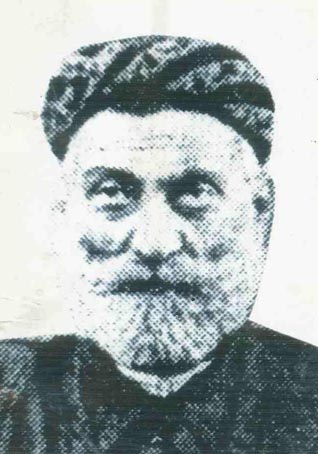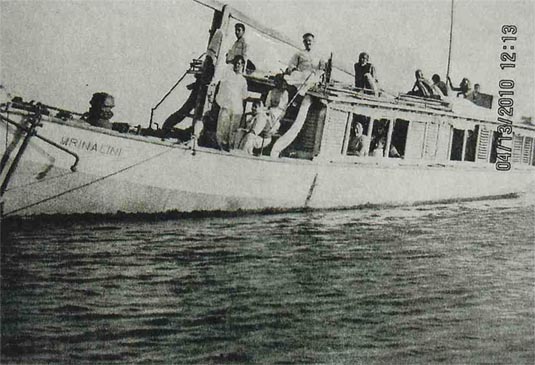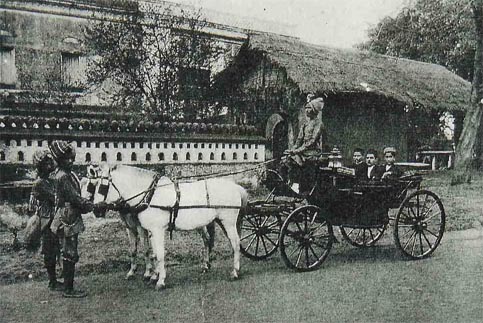Babu Bihari Lal Pandit
The First Kashmiri Oriya Scholar
By Dr. B.N. Sharga
Sometimes in this mad world strange things happen which one cannot
imagine in his life. The British came to India as traders during the reign of
the Mughal emperor Jehangir, but after the battle of Plassey which took
place in 1757 in which Nawab Siraj-ud-Dula of Bengal was defeated by the
British they became a major political player in the country and gradually our
masters by adopting their well known policy of divide and rule. Thus,
Robert Clive who was Charge-de-Affairs of the East India Company at that
time declared himself to be the first British Governor of Bengal.


Babu
Bihari Lal Pandit
The British then in order to govern the country effectively formed three
important Presidencies at the three major port cities of India Calcutta,
Madras and Bombay. The Bengal Presidency was having a very big territory
under its control touching its border in the east with Burma, in the north with
China and in the west with Awadh. The British for the proper and effective
control of this vast territory and for its better administration separated Assam
and Syllhet from it in 1874. Lord Curzon in 1905 further divided Bengal into
East Bengal and West Bengal with the aim to have an effective control over
this area. But this step of the British was very strongly resented by the
Bengali people so much so that in 1911 the British had to annul this partition
of Bengal. The British instead created a new state known as Bihar in 1911.
On 1st April, 1936 another new state known as Orissa was carved out from
this territory for the benefit of Oriya speaking people which was the first
linguistic state to be formed in the country on the basis of any language.
Babu Ganeshi Lal Pandit who was honourable member of the joint
Legislative Council of Bihar and Orissa played an important role in the
creation of this new state. His father Babu Bihari Lal Pandit by that time had
already became a household name for the Oriya speaking people because of
his profound knowledge of the Oriya language and his monumental work of
translating Hindu religious texts and scriptures in the Oriya language for the
benefit of Oriya speaking people of the area specially the translation of
Karma Kand which became extremely popular.
The ancestors of Babu Behari Lal Pandit were originally Tikkus and
residents of Tikku Mohalla of Srinagar district in Kashmir. His immediate
ancestor Gulab Rai Tikku a merchant by profession used to live in
Purushiyar locality of Srinagar. He was a highly orthodox and superstitious
person. His house was located on the bank of the Jhelum river. Being a god
fearing person he used to go every morning to Hari Parbat for his prayers
and other religious rituals with great sincerity and devotion to have the
blessings of the divine power. Every year during the rainy season his house
used to become inaccessible due to flood waters of the Jhelum river making
the lives of its inhabitants quite miserable. One night while he was having a
sound sleep he saw goddess Ragya in his dream who instructed him to
construct an earthen embankment on the bank of Jhelum river to protect his
house from floods. The very next day being an ardent disciple of the goddess
he started the construction of the earthen embankment as per the wishes of
the goddess to protect his house from the fury of the floods in the Jhelum
river. He became so much fascinated with this divine phenomenon of
goddess Ragya Bhagwati appearing in his dream that he changed his original
surname Tikku and in its place adopted a new surname Sutthoo which
means an embankment in the Kashmiri language.

The private boat of the Pandit family in the Bay of Bengal
Gulab Rai Sutthoo had four sons who were Mehtab Rai, Aftab Ram, Daya
Ram and Sahib Ram. His two sons Mehtab Rai who was born around 1784
and Aftab Ram who was born around 1786 then came out from the Kashmir
valley on the pilgrimage in the beginning of the 19th century. After covering
the troublesome journey through thick forest and rough mountainous terrain
they finally landed in the imperial capital Delhi around 1804 during the rule
of Mughal emperor Shah Alam-II(1759-1806) and started living with their
other family members in Bazaar Sita Ram which was a centre of Kashmiri
Pandits’ population in Delhi then.
After sometime finding the conditions in Delhi not to their liking as the city
was facing regular attacks and invasions by the Islamic forces both Mehtab
Rai and Aftab Ram then started their onward journey and went to Mathura a
big centre for Hindu pilgrimage. They paid their obeisance at different
temples in that city and fully enjoyed its religious ambience and fervour.
They wholeheartedly participated in the various religious festivals and
congregations for which the city is famous all over the country.
From Mathura, both these brothers then proceeded to another important city
Haridwar to take a holy dip in the river Ganges there which is considered to
be a must for every devout Hindu to attain salvation. Both Mehtab Rai and
Aftab Ram stayed in Haridwar for couple of years and paid a visit to
different places of religious importance around this city. From Haridwar
they went to Faizabad to pay a visit to Ram Janam Bhoomi site at Ayodhya.
They stayed there at Faizabad for sometime and visited different shrines of
historical and religious importance like Hanuman Garhi, Chandra Hari
Mahadev temple, Sankat Mochan, Swarg Dwar, Janki Mahal, and Sita
Rasoi, etc.
Mehtab Rai and Aftab Ram then came to Lucknow from Faizabad around
1810 during the rule of nawab Sadat-Ali-Khan(1798-1814) in Oudh and
started living with their family in Kashmiri Mohalla which was the biggest
centre of the Kashmiri Pandits population in northern India at that time
in that period Lucknow was quite peaceful and fast growing city with
affluence everywhere as nawab Asaf-ud-Daula who was a liberal ruler was
spending lavishly on its reconstruction as the capital city and the charm of
Delhi was decreasing fast due to regular invasions and bloodshed. Lucknow
being located far away from the borders of the country never faced such
major invasions in its long history. So, it was never a walled city. So,
Kashmiri Mohalla which came into existence between 1775 and 1778 on a
high mound of land surrounded by beautiful gardens and water bodies
became the most favourite destination for Kashmiri Pandits outside the
Kashmir Valley where the Kashmiri Pandits employed in the Awadh court
on high posts built big airy havelis based on Indo-Persian architecture for
the lavish living of their family members.

The mansion of the Pandit family at Chandni Chowk, Cuttack
Both Mehtab Rai and his brother Aftab Rai fully enjoyed the hospitality
extended to them by their community members during their stay at Kashmiri
Mohalla in Lucknow. They also took part in some religious congregations
before leaving for Allahabad to have a holy dip there in the confluence of
Ganges and Yamuna rivers. They liked the ambience of the locality very
much as it had a considerable population of Kashmiri Pandit Purohits and
cooks as well and the pattern of living was almost similar to that of Habba
Kadal in Kashmir. The local residents had their close relatives in Kashmir
and so they used to maintain a very close link with their mother land through
regular visits from both the sides.
Kashi is being regarded as the most pious and holy city by the
Hindus. It is believed that it is resting on the trident of Lord Shiva. The
Kashmiri Pandits are basically Shaivites. So, both Mehtab Rai and his
brother Aftab Ram went from Allahabad to Benares (Varanasi) to pay their
obeisance at the historic Vishwanath temple. They stayed with their relatives
at Ramnagar who were enjoying the patronage of Kashi Naresh at that time.
From Benares they proceeded to Calcutta which was the capital of East India
Company at that time. They paid a visit to Sunderbans where they met with
their acquaintances and enjoyed the hospitality extended to them. From
Calcutta they took a boat for Orissa which was a part of Bengal Presidency
as railway line was not developed by that time. Both these brothers landed at
a marshy land known as Bara peda and took a bullock cart for their onward
journey to Puri as it was the only transport available to cover that distance.
They somehow completed this arduous journey facing a lot of trouble and
finally reached the temple town of Puri and paid their obeisance to Lord
Jagannath. They became so much impressed by the religious ambience of
the place that they dropped the idea of going back to their land of birth and
instead decided to settle down permanently at this place with their family
members.
Both Mehtab Rai and his brother Aftab Ram had a good knowledge
of Sanskrit and Persian language. So, to earn their livelihood they started
writing the petitions of the general public in the lower Diwani Adalat which
was a sort of subordinate court of the higher court at Fort Williams in
Calcutta and was established at Puri to decide petty crimes and small land
disputes. Through this profession of writing petitions, both of them earned a
good amount of money which they invested in purchasing landed properties
for their better living. The local Oriya people gradually started respecting
them for their various philanthropic acts. They purchased a big plot of landof
about 20,000 square feet carpet area in Chandni Chowk, Cuttack on which
they built a huge palatial mansion consisting of 20 rooms and a big
courtyard. Aftab Ram had a son Durga Prasad who was born in 1810 and
died in 1841 at the young age of about 31 years. Mehtab Rai died around
1842 at the age of about 56 years.
It is interesting to note here that the ruler of the princely estate of Kila
Darpan in Orissa somehow became a pauper due to which he could not pay
his share of the land revenue as per agreed terms and conditions to the
British who then confiscated his entire estate and put it on auction to realize
the pending debt. Both Mehtab Rai and Aftab Ram then paid the pending
dues to the British and purchased the entire estate and thus became a ruler
far away from the land of their birth.
Durga Prasad Sutthoo had a son Kanhaiyya Lal Sutthoo who was born at
Chandni Chowk in Cuttack around 1830. He was a pragmatic and farsighted
person. He further consolidated the family fortunes.Kanihaiyya Lal Sutthoo
had a son Babu Bihari Lal Pandit who was born around 1850. Babu Bihari
Lal Pandit was a highly religious and orthodox person. He never believed in
idle gossiping. He had his education in the prestigious The Presidency
College of Calcutta. He had equal command on Sanskrit and Oriya language.
Being the devout and religious person he read all the Hidu scriptires very
thoroughly. As he was a wealthy person and a big landlord so he employed a
dozen script writers to take his dictations in translating the original Sanskrit
text into the Oriya language for the benefit of local Oriya speaking people.
He used to sit in his baithak after taking the breakfast to dictate the
translations of various Hindu religious texts. It was actually a monumental
work on which he spent a big amount of money to get all these translations
printed in the form of books which he used to distribute free of cost to the
local people. His various such philanthropic acts made him very popular
among the local people. Due to his profound knowledge about the Hindu
religion the local residents started calling him as Panditji out of sheer
respect. He then adopted Panditji as his new surname in place of the original
surname Sutthoo.
Babu Bihari Lal Pandit being a big landlord had to maintain a big army of
servants to look after his various landed properties. He had a big collection
of antique armoury like bows and arrows, daggers, swords, spears, foreign
made pistols, revolvers and guns besides various other antique articles. He
was also maintaining a private boat in Bay of Bengal. H was a great lover of
sports and a very strict disciplinarian. Simple living and high thinking was
the main motto of his life. He never tolerated loose talks. He was always
taken in high esteem by the local people. He played an important role in
restoring the lands which were mortgaged by the Trust of Jagannath Temple
of Puri.
Babu Bihari Lal Pandit was a man of many dimensional personalities. He
was a keen observer, a meticulous planner and above all a very hard task
master. He was a voracious reader and had a big collection of books on
different subjects in his personal library. The ruler of Puri used to give him a
great respect for his profound knowledge about the Hindu religion and
philosophy. His wife Manorama was very supportive in his various pursuits
due to which he could pursue all his ventures with great ease without any
mental blockade. Though he was a sort of feudal lord of that era yet he
always recognized the dignity of labour and duly rewarded all those who
were of laborious nature. Many youngsters of that period used to take him as
their role model. He was very fond of organizing religious congregations
and festivals on which he used to spend quite lavishly. He authored many
books mostly on Hindu religion and philosophy. He always gave due
importance to time management as work was worship for him.
Babu Bihari Lal Pandit unfortunately had no son. He had only three
daughters: Mohan Rani, Beno Rani and Munni Rani. In that era the
daughters had no right of inheritance in the ancestral property. So, to look
after his vast landed properties he went to his native place Kashmir to adopt
a son from one of his relatives family. Thus, in 1891 Babu Bihari Lal Pandit
adopted Ganeshi Lal who was hardly 2 years old at that time. Ganeshi Lal
Pandit was brought up at Chandni Chowk, Cuttack and also had schooling in
the same city. Ganeshi Lal Pandit had a political bent of mind. He became
an honourable member of the joint Legislative Council of Bihar and Orissa
and played a key role in the creation of the state of Orissa in 1936.
Babu Bihari Lal Pandit died in 1911 after living a king size life. Ganeshi Lal
Pandit had two sons: Moti Lal and Heera Lal who died quite young besides
3 daughters Swaroop Kumari married with Brij Kishen Zutshi of Kashmiri
Mohalla Lucknow, Jagat Kumari married with Raj Nath Ganjoor of Rani
Katra Lucknow and Roop Kumari married with Bishen Narain Channa of
Delhi.
Vinayak Damodar Bhave who was born in 1895 at Colaba Bombay became
popularly known as Acharya Vinoba Bhave. He was considered as the
spiritual heir of Mahatma Gandhi. He started the famous Bhoodan
Movement in 1951 for which he travelled throughout the length and breadth
of the country on foot asking people to donate their extra land to him for a
noble cause. Vedre Ram Chandra Reddy of the village Pochampally in
Andhra Pradesh was the first wealthy landlord of that state who donated his
village to Acharya Vinoba Bhave. Moti Lal Pandit also came into magical
spell of Acharya Vinoba Bhave and donated his village to him in Orissa.
Thus, he became the second person to do the same.
Ganeshi Lal Pandit was married
with Girija Rani Mushran who was the
maternal granddaughter of Raja Dina Nath Madan of
Lahore
now in
Pakistan
. He alongwith Utkalmani Madhusudan Das played an important
role for the betterment and development of the newly created Orissa state.
Moti Lal Pandit had his early schooling in the mission school
Cuttack
. He
graduated with Honours in Sanskrit from the
Raven
Shaw
College
,
Cuttack
.
He also did his graduation in Law but his father did not allow him to do
legal practice so that he may not neglect his zamindari obligations. He was a
keen sportsperson during his college days. He was a champion of tennis. The
college has instituted Moti Cup for tennis in his honour. He was a true
Gandhian in letter and spirit. He was elected as a Rajya Sabha member from
Cuttack
in 1952. Later on he became the chairman of the Orissa Public
Service Commission. He had two sons: Ashok Pandit and Arvind Pandit
besides two daughters Ansuiyya married with Deepak Mushran of
Lucknow
and
Annapurna
married with Suman Chak the grandson of barrister
JagMohan Nath Chak of
Lucknow
. Ashok Pandit was employed with the
TATAs at
Jamshedpur
and is married with Neelima the daughter of barrister Suresh Narain Mulla of
Allahabad
. Arvind Pandit qualified the IAS
examination and became a bureaucrat. He was married with Niti the
daughter of bureaucrat Sunder Prakash Watal of
Lucknow
.
Great men leave behind their
footprints on the sands of time.
| 